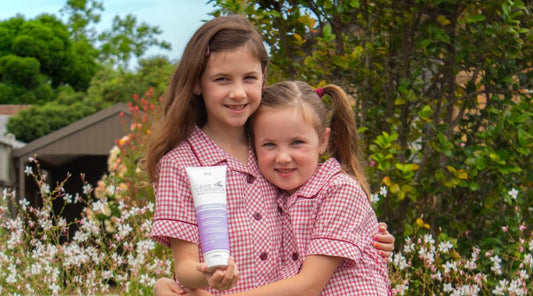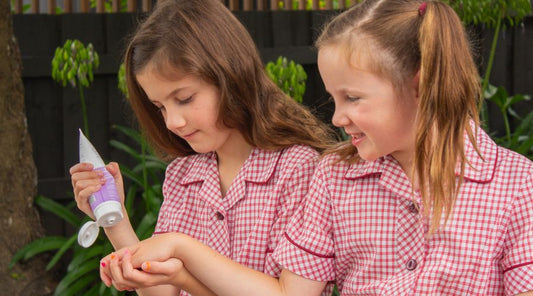What does it take to make a natural sandfly repellent?

When Natural Wonders first started, we were just a small market stall based out of the Mindil markets up in Darwin. Every season we'd see thousands of tourists pass through and one consistently common topic of conversation was about how bad the sandflies were. It became clear very quickly that there was a strong need for a natural sandfly repellent.
For many southerners and city dwellers, sandflies aren't really a common issue. Many of the travellers we came across didn't even know what a sandfly was until they came up to Darwin! But it didn't take long for them to become familiar with the agonising itch, swelling and irritation from the pesky little buggers...
While sandflies don't transmit diseases between human, sometimes their bite can be even worse than a mozzie bite.
First, we need to clear up the common misconception that sandflies don't bite, they wee on you. This isn't true.
Sandflies, biting midges or no-see-ums as they're commonly referred to, are a range of species of incredibly small biting flies. They can range in size from around 4mm right down to around 0.5mm which makes it really easy for them to snack on you without you noticing.
When sandflies bite, they break the skin using a specialised mouthpiece that essentially saws into your skin. They then inject saliva to prevent your blood from clotting to make it easier to drink your blood.
The saliva is what makes you itch and for a lot of people, it triggers an allergic reaction which causes your skin to turn red, angry and itchy (and in some rare cases, can cause an anaphylactic reaction).
For many people though, it can take a number of hours for the bite to flare up. This is why sandflies are so annoying! By the time you notice you've been bitten, the sandfly is long gone.
Regular DEET-based repellents are supposed to protect against sandflies but our experience up in Darwin was that regular repellents just didn't work that well.
One really popular sandfly repellent home-remedy was the old baby oil, Dettol and eucalyptus oil mix. The smell combined with the physical barrier created by the baby oil was supposed to help prevent the bites. But the smell also seemed to repel other humans... and it wasn't worth all of the baby oil stains on our clothes and furniture.
But this home-remedy did give us a little clue as to what we would need to do to create a natural sandfly repellent that actually works - it needed a physical barrier!
There are two ways that Good Riddance helps to protect you against the sandflies and midges.
Good Riddance is first and foremost an insect repellent. The essential oil actives help to shield the smell of your skin from sandflies (and mozzies), which deters them from landing on you in the first place. Independent field trials up in Bundaberg found that when you wear Good Riddance, fewer sandflies will land on you which means less bites overall.
Every now and then, you'll find that a pesky sandfly that doesn't seem to be repelled by the smell of the repellent. Our (definitely incorrect) theory is that they have a sinus infection and can't smell the repellent (haha).
Because Good Riddance is a cream rich with shea butter and beeswax, it leaves a lightweight barrier on your skin which seems to be enough to stop the sandflies from irritating your skin if they do happen to land on you.
Our Sensitive range of repellents are a richer cream with a higher proportion of shea butter and beeswax. We find that the Sensitive repellent is better for sandfly magnets.
Check out the Good Riddance Sensitive range here.
Yes! Good Riddance is proof that a sandfly repellent doesn't need to be filled with DEET to work.
Good Riddance has been tested by fishermen across Australia, including the most sandfly-prone mangrove swaps up in Darwin and Northern Queensland. We've also had the range tested by an independent lab up in Bundaberg so we could say that the products actually work (and register our range with the APVMA).
When choosing a natural sandfly repellent, keep an eye out for the APVMA registration number which means the product is safe and proven to work!
Good Riddance Insect Repellent is available through our online store here. Or, you can find a local stockist using our stockist map here.
Say goodbye to sandfly bites, plus sticky, smelly DEET-based repellents. Good Riddance is designed for everyday use in the harshest tropical conditions.
For many southerners and city dwellers, sandflies aren't really a common issue. Many of the travellers we came across didn't even know what a sandfly was until they came up to Darwin! But it didn't take long for them to become familiar with the agonising itch, swelling and irritation from the pesky little buggers...
While sandflies don't transmit diseases between human, sometimes their bite can be even worse than a mozzie bite.
Why do sandfly bites itch so badly?
First, we need to clear up the common misconception that sandflies don't bite, they wee on you. This isn't true.
Sandflies, biting midges or no-see-ums as they're commonly referred to, are a range of species of incredibly small biting flies. They can range in size from around 4mm right down to around 0.5mm which makes it really easy for them to snack on you without you noticing.
When sandflies bite, they break the skin using a specialised mouthpiece that essentially saws into your skin. They then inject saliva to prevent your blood from clotting to make it easier to drink your blood.
The saliva is what makes you itch and for a lot of people, it triggers an allergic reaction which causes your skin to turn red, angry and itchy (and in some rare cases, can cause an anaphylactic reaction).
For many people though, it can take a number of hours for the bite to flare up. This is why sandflies are so annoying! By the time you notice you've been bitten, the sandfly is long gone.
Do regular repellents protect against sandflies?
Regular DEET-based repellents are supposed to protect against sandflies but our experience up in Darwin was that regular repellents just didn't work that well.
One really popular sandfly repellent home-remedy was the old baby oil, Dettol and eucalyptus oil mix. The smell combined with the physical barrier created by the baby oil was supposed to help prevent the bites. But the smell also seemed to repel other humans... and it wasn't worth all of the baby oil stains on our clothes and furniture.
But this home-remedy did give us a little clue as to what we would need to do to create a natural sandfly repellent that actually works - it needed a physical barrier!
How does Good Riddance repel and protect against the sandflies?
There are two ways that Good Riddance helps to protect you against the sandflies and midges.
1. It is a natural sandfly repellent
Good Riddance is first and foremost an insect repellent. The essential oil actives help to shield the smell of your skin from sandflies (and mozzies), which deters them from landing on you in the first place. Independent field trials up in Bundaberg found that when you wear Good Riddance, fewer sandflies will land on you which means less bites overall.
2. It creates a physical barrier
Every now and then, you'll find that a pesky sandfly that doesn't seem to be repelled by the smell of the repellent. Our (definitely incorrect) theory is that they have a sinus infection and can't smell the repellent (haha).
Because Good Riddance is a cream rich with shea butter and beeswax, it leaves a lightweight barrier on your skin which seems to be enough to stop the sandflies from irritating your skin if they do happen to land on you.
Our Sensitive range of repellents are a richer cream with a higher proportion of shea butter and beeswax. We find that the Sensitive repellent is better for sandfly magnets.
Check out the Good Riddance Sensitive range here.
Can a natural sandfly repellent actually work?
Yes! Good Riddance is proof that a sandfly repellent doesn't need to be filled with DEET to work.
Good Riddance has been tested by fishermen across Australia, including the most sandfly-prone mangrove swaps up in Darwin and Northern Queensland. We've also had the range tested by an independent lab up in Bundaberg so we could say that the products actually work (and register our range with the APVMA).
When choosing a natural sandfly repellent, keep an eye out for the APVMA registration number which means the product is safe and proven to work!
Where can you buy a natural sandfly repellent?
Good Riddance Insect Repellent is available through our online store here. Or, you can find a local stockist using our stockist map here.
Say goodbye to sandfly bites, plus sticky, smelly DEET-based repellents. Good Riddance is designed for everyday use in the harshest tropical conditions.


